Evaluation of Critical Thresholds for Surrounding Rock Stability in TBM Tunnels Utilizing Limit State Analysis
Abstract
:1. Introduction
2. Numerical Model Establishment and Verification
3. Critical Thresholds
3.1. Displacement
- (1)
- Construct a two-dimensional plane strain numerical model of tunnel excavation with the release of surrounding rock stress. After the stage of the equilibrium of initial ground stress field, remove the inner part of the tunnel and replace with a decreased support stress along edge of the tunnel compared with the original earth stress, and evaluate the model again. This replaced support stress is set to be uniformly released, and the deformation values of tunnel monitoring points are then extracted at each stress release stage [19].
- (2)
- Plot the curve of the deformation of tunnel monitoring points versus the stress release rate. Find out the threshold value where the displacement shows a sharp increase when the stress release rate exceeds this value (e.g., 0.9 as shown in Figure 4). This condition is considered to reach the limit state.
- (3)
- Extract the displacement corresponding to the stress release stage at the limit state of instability. This serves as the warning value of displacement (Figure 4).
3.2. Deformation Velocity
4. Numerical Simulations of Ultimate Displacement
4.1. Results
4.2. Response Surface
5. Conclusions
- (1)
- A finite different model for tunnel excavation is established based on the stress release process. Using this model, a standardized criterion of the point where a notable surge in displacement with the stress release process is observed is developed for assessing tunnel instability. This point is defined as the limit state of the tunnel. The observed displacement at this point is regarded as the limit displacement, and the slope is regarded as the deformation velocity.
- (2)
- As tunnel excavation depths and diameters increase, there is a corresponding gradual increase in both the limit displacement and deformation velocity. This trend is particularly pronounced in scenarios involving deeper excavations and larger diameters, where the rock mass quality is lower. These observations emphasize the complex interplay between rock mass characteristics, tunnel geometry, and stability considerations, underscoring the need for meticulous planning in tunneling projects.
- (3)
- The sensitivity analysis conducted by the MARS model reveals that tunnel depth exerts the most substantial influence on warning indicator values, followed closely by rock mass quality (BQ). Conversely, tunnel diameter exhibits the least impact on these indicators. This comprehensive evaluation provides valuable insights into the relative importance of each parameter at the design stage of tunnel, offering pertinent information for engineering decision making and design optimization.
- (4)
- A series of response surfaces is developed to enhance the prediction of limit displacement and deformation velocity for tunnels under diverse scenarios. The rock mass quality, tunnel depth, and diameter are considered in these surfaces. Their utilization helps engineers with the evaluation of tunnel stability, and allows for a better understanding of the parameters and more accurate predictions for displacement and deformation velocity.
Author Contributions
Funding
Data Availability Statement
Conflicts of Interest
References
- Carranza-Torres, C.; Fairhurst, C. The elasto-plastic response of underground excavations in rock masses that satisfy the Hoek-Brown failure criterion. Int. J. Rock Mech. Min. 1999, 36, 777–809. [Google Scholar] [CrossRef]
- Oreste, P.P. Analysis of structural interaction in tunnels using the covergence-confinement approach. Tunn. Undergr. Space Technol. 2003, 18, 347–363. [Google Scholar] [CrossRef]
- Xu, Y.; Li, Y.; Qiu, J. Application of Inclination Sensor in Real-Time Remote Monitoring System of Tunnel Structure Deformation. Wirel. Commun. Mob. Comput. 2022, 2022, 8079543. [Google Scholar] [CrossRef]
- Song, Y.; Liu, Y.; Zhu, Y. Application of response surface method to reliability analysis of monolithic lining of railway tunnel. Chin. J. Rock Mech. Eng. 2004, 23, 1847–1851. (In Chinese) [Google Scholar]
- Su, Y.; Fang, Z.; Gao, Q. Reliability Analysis on Special Underground Rockmass Space by Response Surface Method. Chin. J. Rock Mech. Eng. 2000, 19, 55–58. (In Chinese) [Google Scholar]
- Liu, P.L.; Liu, K.G. Selection of Random Field Mesh in Finite Element Reliability Analysis. J. Eng. Mech. 1993, 119, 667–680. [Google Scholar] [CrossRef]
- TB 10121-2007; Technical Specification for Monitoring Measurement of Railway Tunnel. PRC Ministry of Railways: Beijing, China, 2007.
- Wittke, W.; Pierau, B.; Erichsen, C. New Austrian Tunneling Method (NATM)–Stability Analysis and Design; WBI: Essen, Germany, 2006; Volume 2441. [Google Scholar]
- Tan, L.J.; Zhou, H.Q.; Chen, K.S. Discussion on highway tunnel monthitoring measurement control standards. Appl. Mech. Mater. 2014, 580, 1127–1133. [Google Scholar] [CrossRef]
- Skempton, A.W.; MacDonald, D.H. The allowable settlements of buildings. Proc. Inst. Civ. Eng. 1956, 5, 727–768. [Google Scholar] [CrossRef]
- Ning, Z. Discussion on Safety Prediction and Forecast of Tunnel Construction. Master’s Thesis, Southwest Jiaotong University, Chengdu, China, 2001. (In Chinese). [Google Scholar]
- Yu, W.; Zhou, M.; Liu, X. Deformation and Stability Analysis of Highway Tunnel Based on Monitoring Data. In Proceedings of the 11th National Conference on Rock Mechanics and Engineering, Trentino, Italy, 20–24 June 2010. [Google Scholar]
- Liu, X.; Su, J.; Wang, X. Statistical analysis on time effects and evaluation Index of deformation stability to NATM surrounding rock deformation. China Civ. Eng. J. 2009, 42, 115–120. (In Chinese) [Google Scholar]
- Wu, X.; Yang, X.; Li, Y.; Zhang, J. Research on Control Indices and Deformation Characteristic of Shallow Tunnel with Weak Interlayer. Chin. J. Rock Mech. Eng. 2014, 33, 2685–2691. (In Chinese) [Google Scholar]
- Jaky, J. Pressure in silos. In Proceedings of the Second International Conference on Soil Mechanics and Foundation Engineering, Rotterdam, The Netherlands, 21–30 June 1948; Volume 1, pp. 103–107. [Google Scholar]
- Carranza-Torres, C. Dimensionless graphical representation of the exact elasto-plastic solution of a circular tunnel in a Mohr-Coulomb material subject to uniform far-field stresses. Rock Mech. Rock Eng. 2003, 36, 237–253. [Google Scholar] [CrossRef]
- GB/T 50218-2014; Engineering Rock Mass Classification Standard. Ministry of Water Resources: Beijing, China, 2014.
- Qiao, L.; Liu, J.; Li, S.; Wang, Z.; Jiang, Y.; Wang, Z. Study of spatial effect of excavation face for underground facility and its application. Rock Soil Mech. 2014, 35, 481–487. (In Chinese) [Google Scholar]
- Carranza-Torres, C.; Fairhurst, C. Application of the convergence-confinement method of tunnel design to rock masses that satisfy the Hoek-Brown failure criterion. Tunn. Undergr. Space Technol. 2000, 15, 187–213. [Google Scholar] [CrossRef]
- Sun, Z. The Synergetic Principle and Design Method of Tunnel Support System. Ph.D. Thesis, Beijing Jiaotong University, Beijing, China, 2020. (In Chinese). [Google Scholar]
- Wu, S.; Geng, X.; Gao, Y.; Zhao, G.; Li, J.; Yan, Q. A study of the longitudinal deformation of tunnels based on the generalized Hoek-Brown failure criterion. Rock Soil Mech. 2015, 36, 946–952+987. [Google Scholar]
- Hoek, E. Hoek-Brown failure criterion-2002 edition. In Proceedings of the Fifth North American Rock Mechanics Symposium, Toronto, ON, Canada, 7–10 July 2002; Volume 1, pp. 18–22. [Google Scholar]
- Zhu, Y.; Zhang, S.; Jing, S. Concept and Determination of limit Displacements of Primary Support System of Railway Tunnel. Chin. J. Rock Mech. Eng. 2005, 24, 1594–1598. (In Chinese) [Google Scholar]
- Wu, C. R&D and Application of Construction Monitoring and Collapse Dynamic Analysis Pre-Warning System for Tunnel. Master’s Thesis, Chengdu University of Technology, Chengdu, China, 2017. (In Chinese). [Google Scholar]
- Friedman, J.H. Multivariate Adaptive Regression Splines. Ann. Stat. 1991, 19, 1–67. [Google Scholar] [CrossRef]
- Zheng, G.; Zhang, W.; Zhou, H.; Yang, P. Multivariate adaptive regression splines model for prediction of the liquefaction-induced settlement of shallow foundations. Soil Dyn. Earthq. Eng. 2020, 132, 106097. [Google Scholar] [CrossRef]
- Zhou, H.-Z.; Zheng, G.; He, X.-P.; Wang, E.-Y.; Guo, Z.-Y.; Nie, D.-Q.; Ma, S.-K. Numerical modelling of retaining structure displacements in multi-bench retained excavations. Acta Geotech. 2020, 15, 2691–2703. [Google Scholar] [CrossRef]
- Liu, L.; Zhang, S.; Cheng, Y.-M.; Liang, L. Advanced reliability analysis of slopes in spatially variable soils using multivariate adaptive regression splines. Geosci. Front. 2019, 10, 671–682. [Google Scholar] [CrossRef]

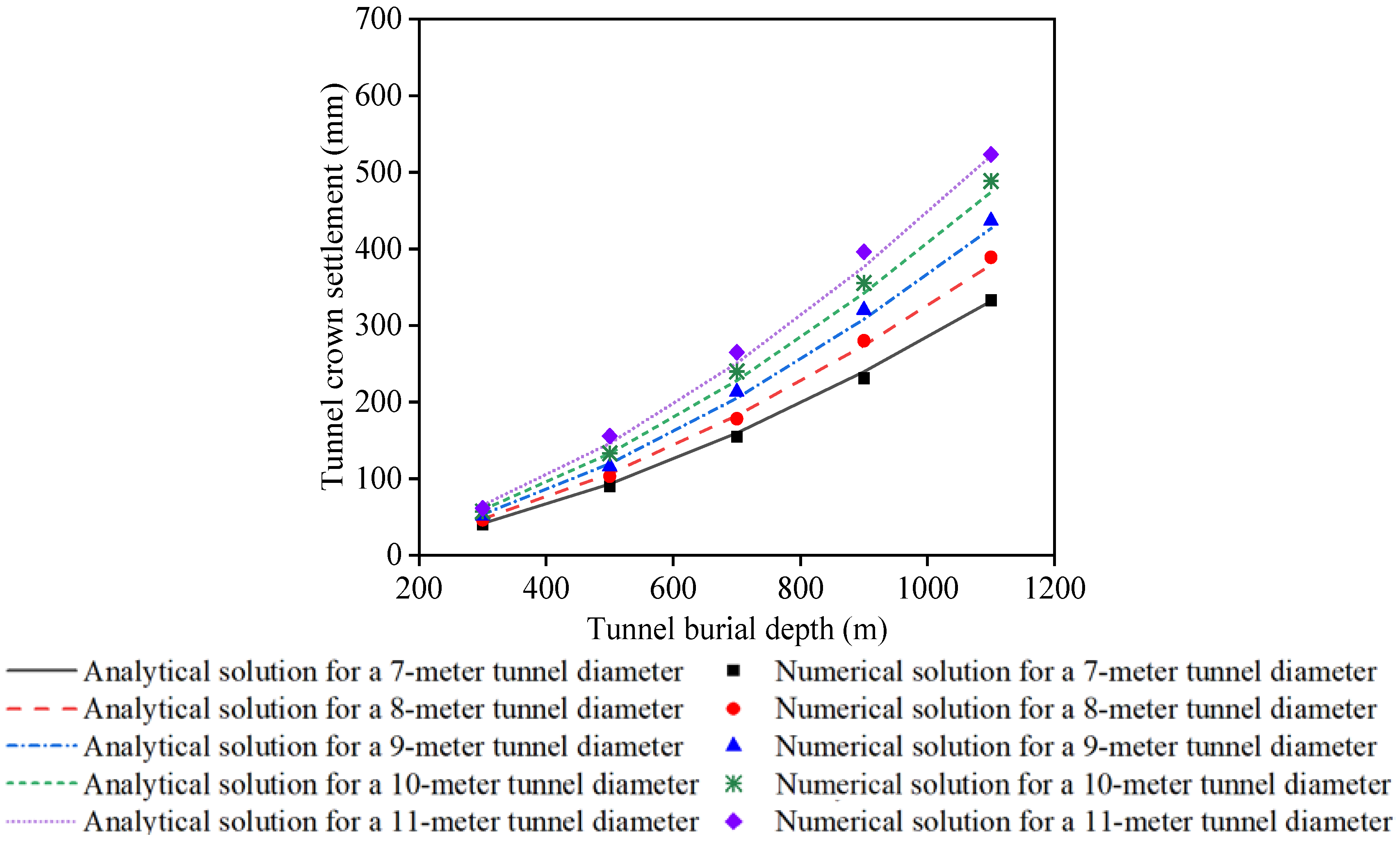

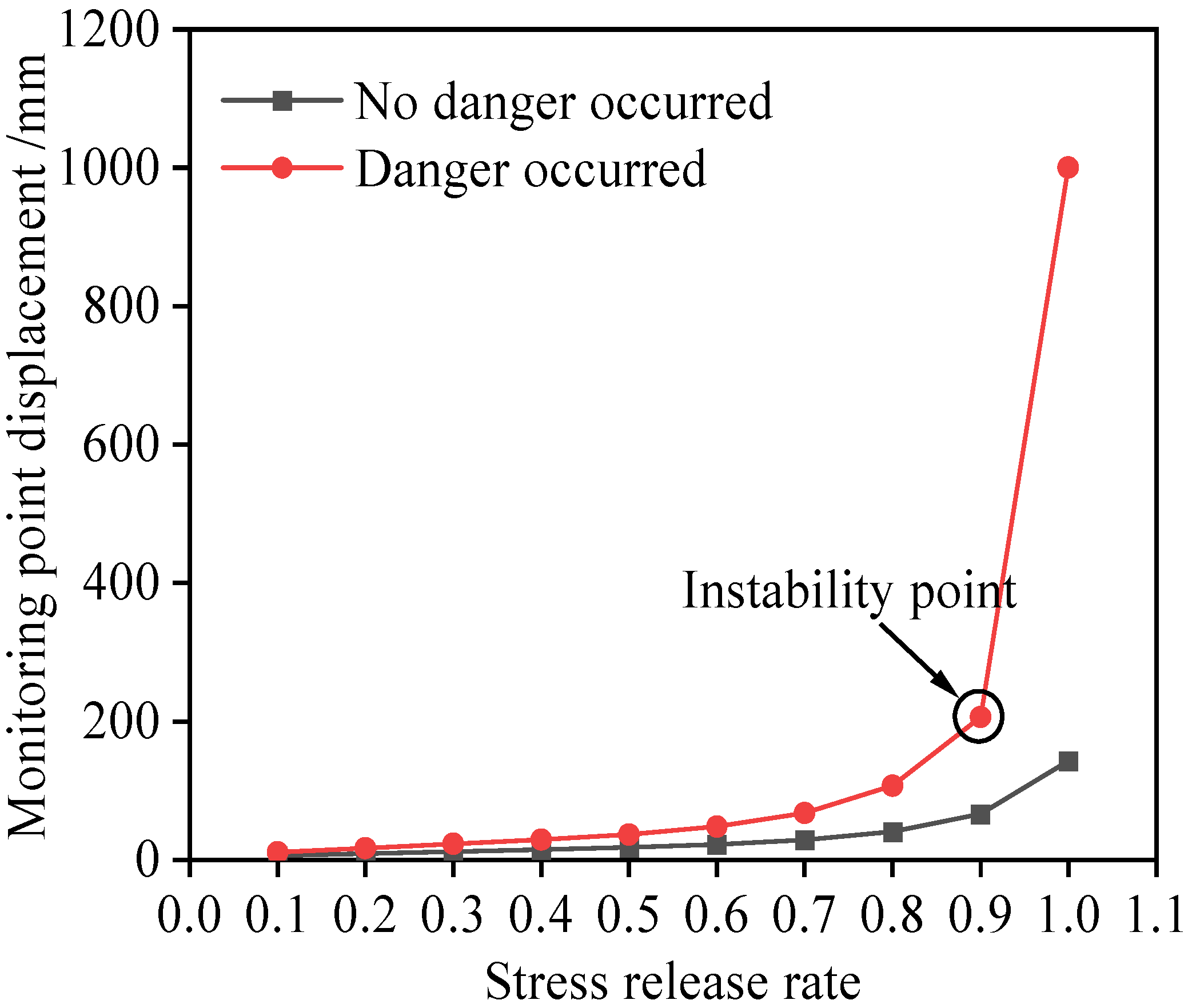

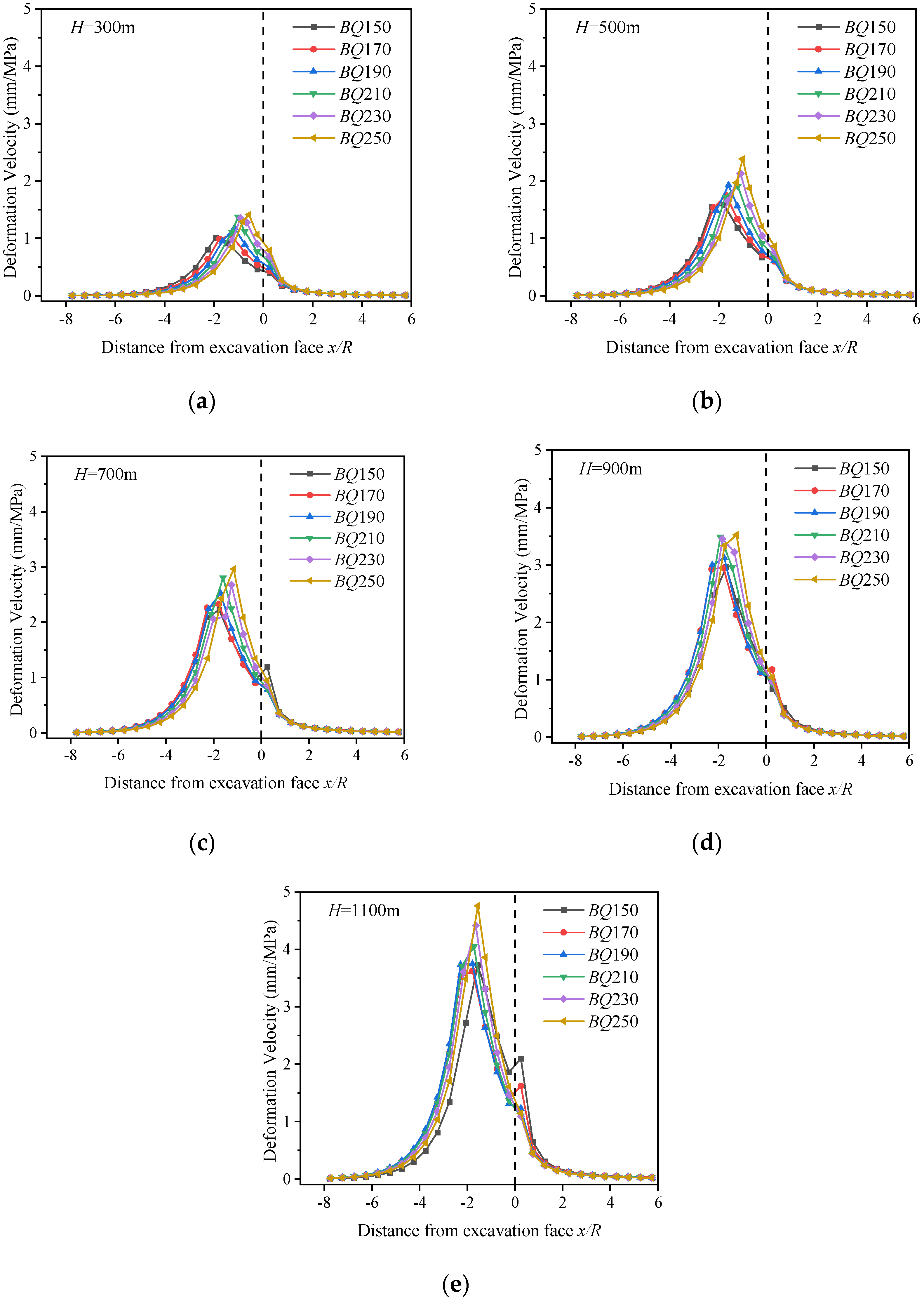
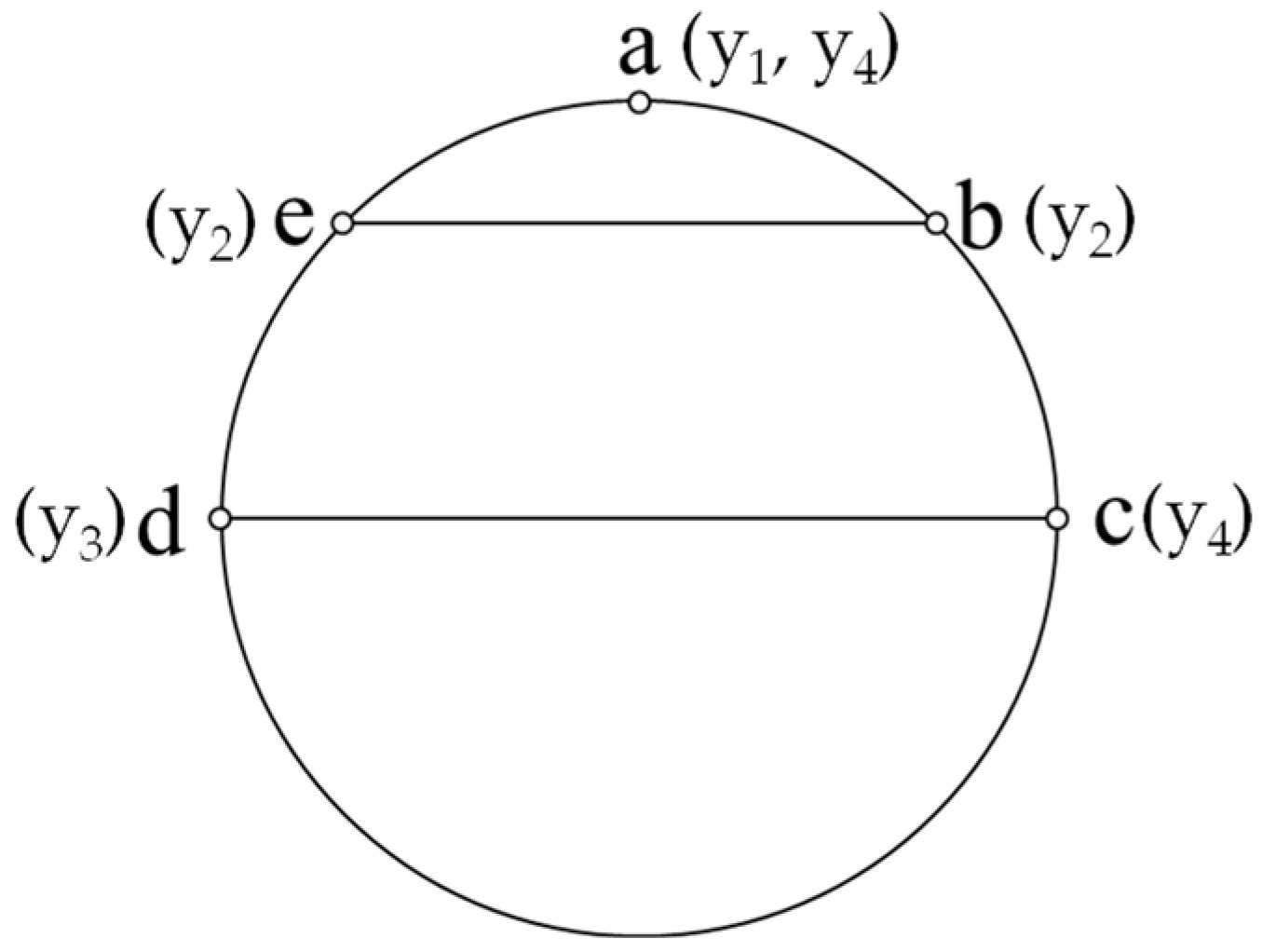
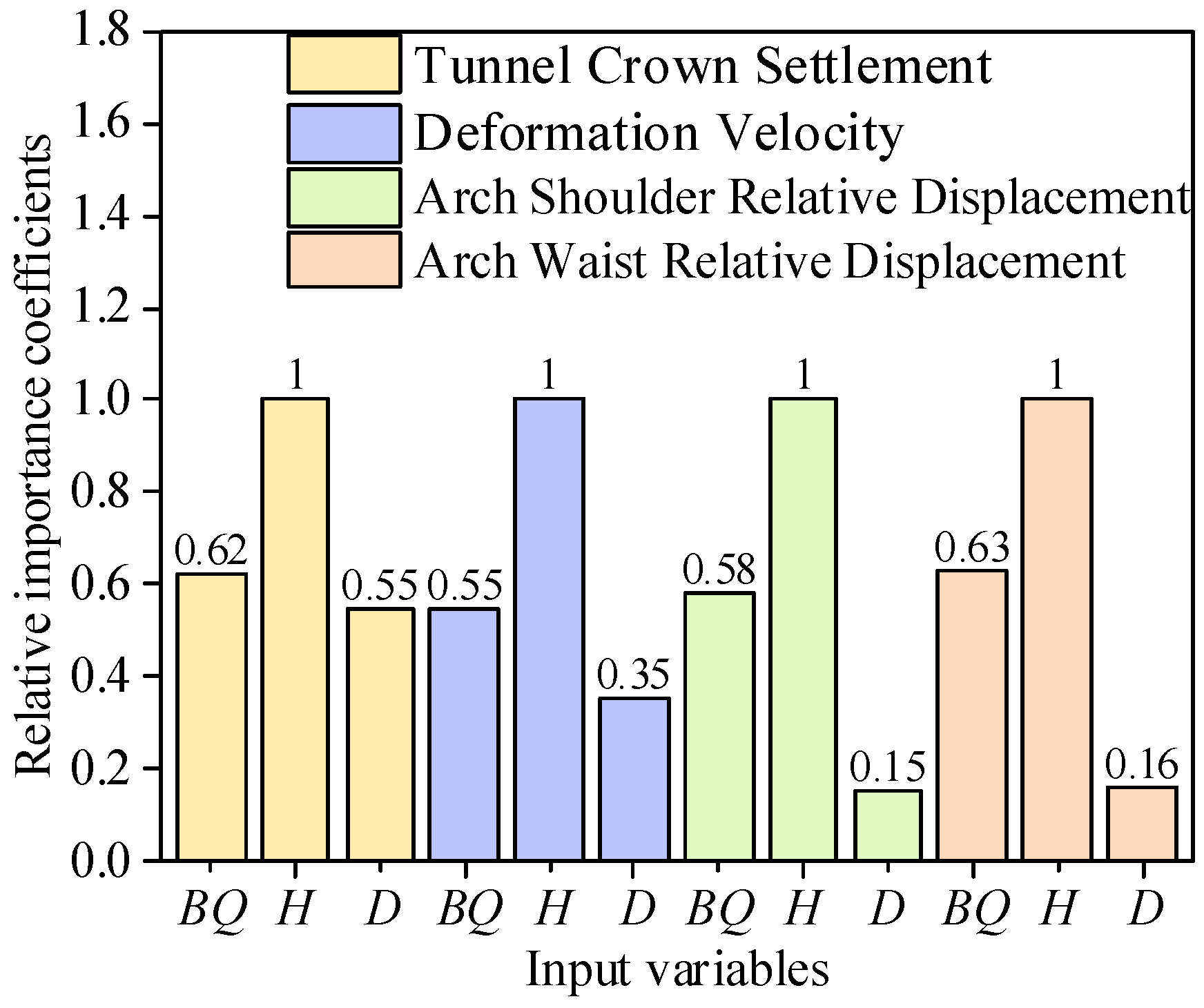
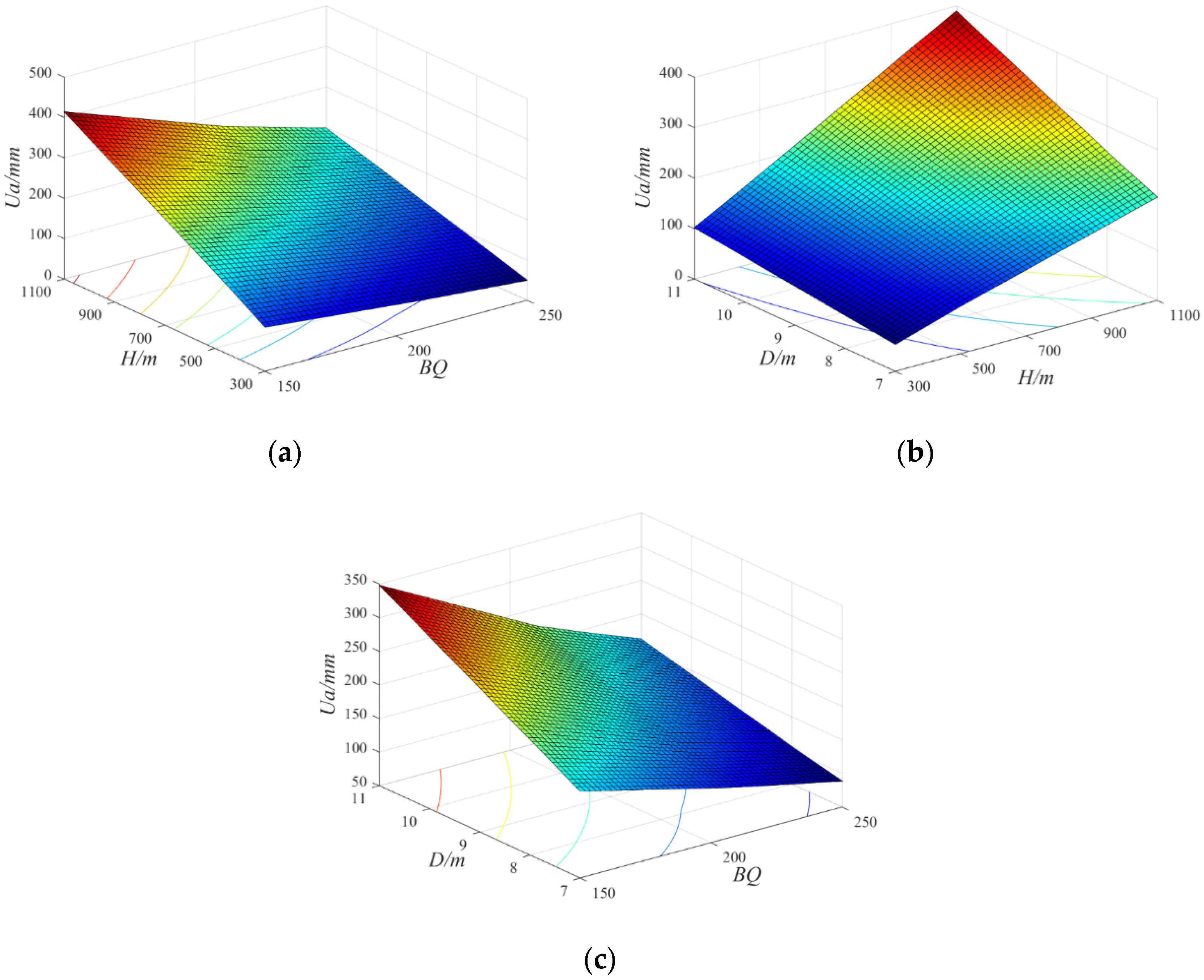
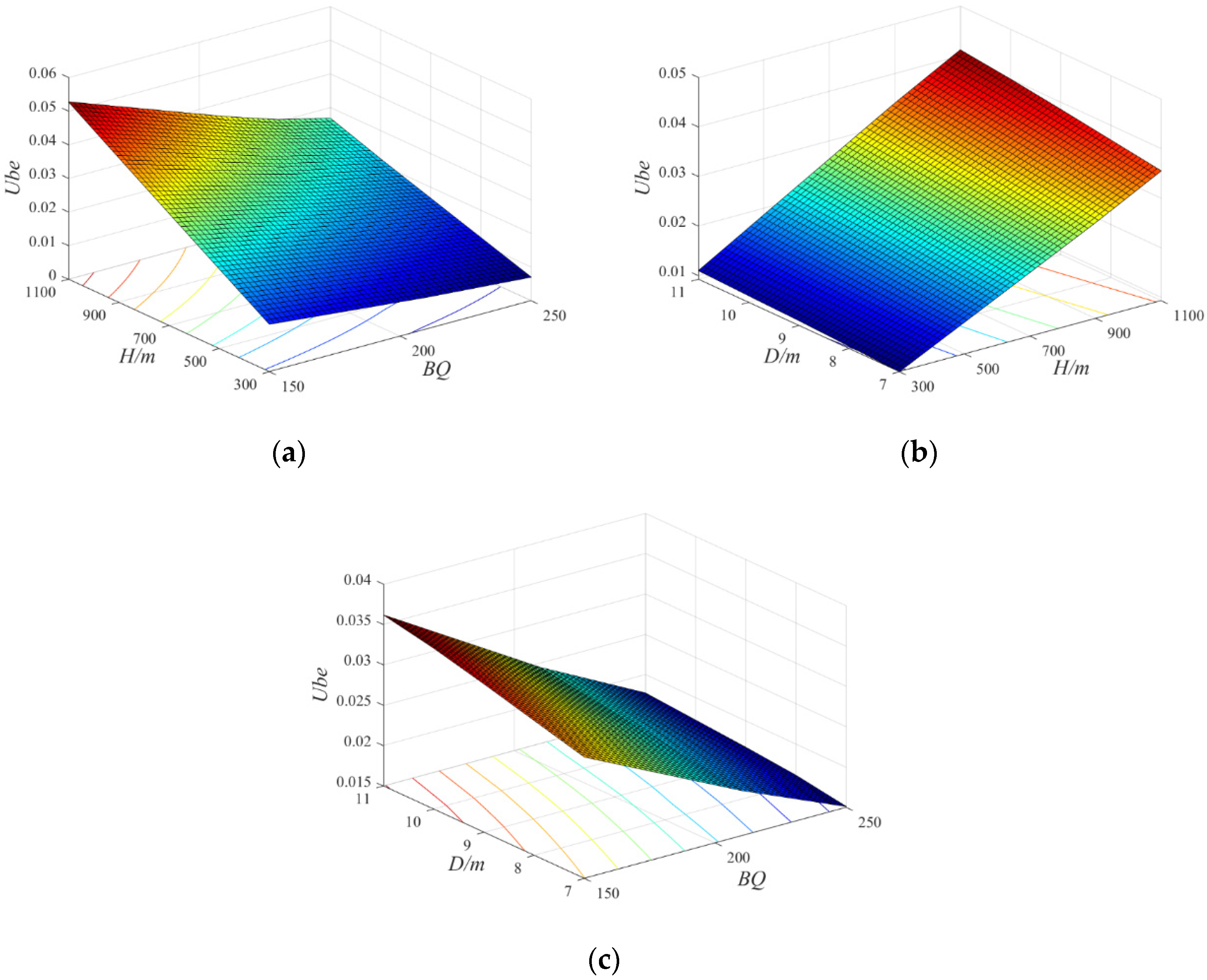

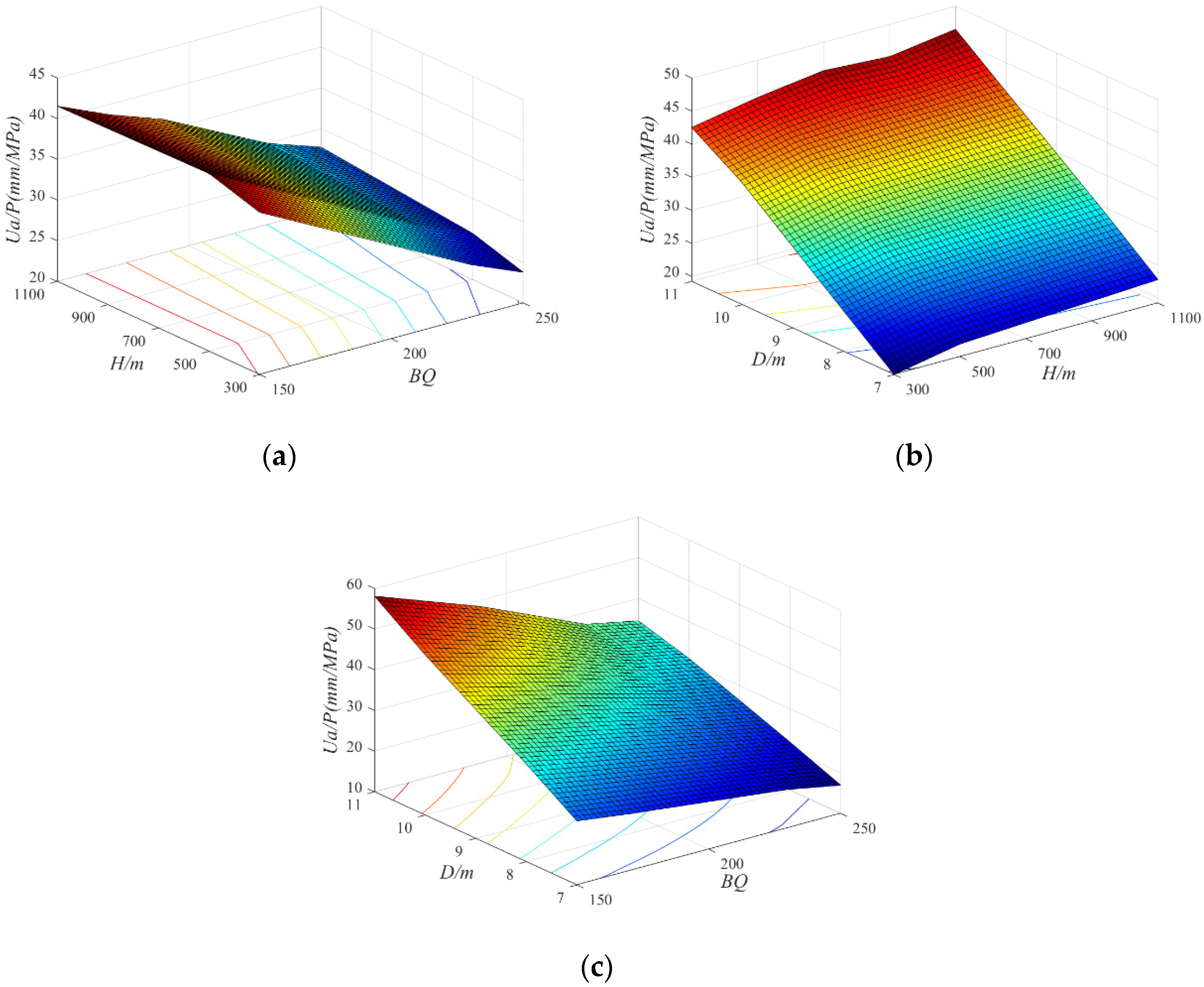
| Rock Mass Classification | BQ | c/MPa | φ/° | E/GPa | μ | γ/kN/m3 |
|---|---|---|---|---|---|---|
| II | 451~550 | 1.22~2.54 | 51.4~57.9 | 10.2~32.7 | 0.20~0.25 | 26 |
| III | 351~450 | 0.68~1.22 | 42.6~51.4 | 3.17~10.2 | 0.25~0.30 | 25.5 |
| IV | 251~350 | 0.26~0.68 | 27.9~42.6 | 0.66~3.17 | 0.30~0.35 | 23.5 |
| V | 150~250 | 0.14~0.26 | 21.4~27.9 | 0.26~0.66 | 0.35~0.45 | 19.8 |
| Rock Mass Classification | BQ | c/MPa | φ/° | E/GPa | μ |
|---|---|---|---|---|---|
| V | 150 | 0.14 | 21.4 | 0.26 | 0.45 |
| 170 | 0.17 | 22.9 | 0.31 | 0.43 | |
| 190 | 0.19 | 24.2 | 0.37 | 0.41 | |
| 210 | 0.22 | 25.5 | 0.45 | 0.39 | |
| 230 | 0.24 | 26.7 | 0.55 | 0.37 | |
| 250 | 0.26 | 27.9 | 0.66 | 0.35 |
| Depth/m | Monitoring Item | Mean | Variance | Confidence Interval |
|---|---|---|---|---|
| 300 | Vault Settlement (mm) | 78.970 | 733.936 | (68.86845, 89.07155) |
| Shoulder Relative Displacement | 0.0103 | 0.00001 | (0.009355, 0.011292) | |
| Waist Relative Displacement | 0.0174 | 0.00002 | (0.015665, 0.019117) | |
| Deformation Velocity (mm/MPa) | 1.6529 | 0.30502 | (27.49294, 35.31830) | |
| 500 | Vault Settlement (mm) | 136.45 | 2109.66 | (119.3236, 153.5764) |
| Shoulder Relative Displacement | 0.0175 | 0.00002 | (0.015863, 0.019069) | |
| Waist Relative Displacement | 0.0301 | 0.00006 | (0.027154, 0.032961) | |
| Deformation Velocity (mm/MPa) | 3.0193 | 0.92337 | (29.27040, 37.15301) | |
| 700 | Vault Settlement (mm) | 190.44 | 4299.62 | (165.9903, 214.8897) |
| Shoulder Relative Displacement | 0.0246 | 0.00004 | (0.022368, 0.026845) | |
| Waist Relative Displacement | 0.0419 | 0.00012 | (0.037762, 0.046058) | |
| Deformation Velocity (mm/MPa) | 4.4745 | 1.93899 | (29.94677, 37.80916) | |
| 900 | Vault Settlement (mm) | 246.66 | 7235.75 | (214.9424, 278.3776) |
| Shoulder Relative Displacement | 0.0318 | 0.00006 | (0.028912, 0.034703) | |
| Waist Relative Displacement | 0.0542 | 0.00020 | (0.048924, 0.059536) | |
| Deformation Velocity (mm/MPa) | 6.0042 | 2.91517 | (30.41619, 37.63139) | |
| 1100 | Vault Settlement (mm) | 301.93 | 10970.9 | (262.8746, 340.9854) |
| Shoulder Relative Displacement | 0.0389 | 0.00009 | (0.035368, 0.042442) | |
| Waist Relative Displacement | 0.0664 | 0.00031 | (0.059824, 0.072911) | |
| Deformation Velocity (mm/MPa) | 7.7081 | 4.96734 | (30.63403, 38.03783) |
| BF | Equation | BF | Equation |
|---|---|---|---|
| BF1 | Max (0, H − 500) | BF11 | BF4 × max (0, H − 500) |
| BF2 | Max (0, 500 − H) | BF12 | BF4 × max (0, 500 − H) |
| BF3 | Max (0, BQ − 210) | BF13 | BF4 × max (0, D − 8) |
| BF4 | Max (0, 210 − BQ) | BF14 | BF4 × max (0, 8 − D) |
| BF5 | BF1 × max (0, D − 8) | BF15 | BF3 × max (0, H − 500) |
| BF6 | BF1 × max (0, 8 − D) | BF16 | BF3 × max (0, 500 − H) |
| BF7 | BF5 × max (0, BQ − 230) | BF17 | BF2 × max (0, 11 − D) |
| BF8 | BF5 × max (0, 230 − BQ) | BF18 | BF3 × max (0, D − 8) |
| BF9 | Max (0, D − 8) | BF19 | BF3 × max (0, 8 − D) |
| BF10 | Max (0, 8 − D) | BF20 | BF12 × max (0, D − 8) |
| BF21 | BF12 × max (0, 8 − D) | ||
| y1 = 105.23 + 0.20816 × BF1 − 0.31824 × BF2 − 0.7668 × BF3 + 0.927 × BF4 + 0.033446 × BF5 − 0.040306 × BF6 − 0.00031569 × BF7 + 0.00044958 × BF8 + 17.316 × BF9 − 17.019 × BF10 + 0.0016186 × BF11 − 0.001903 × BF12 + 0.18176 × BF13 − 0.29323 × BF14 − 0.0012991 × BF15 + 0.0016717 × BF16 + 0.030553 × BF17 − 0.092463 × BF18 + 0.20584 × BF19 − 0.00044172 × BF20 + 0.0010429 × BF21 | |||
| BF | Equation | BF | Equation |
|---|---|---|---|
| BF1 | max (0, H − 900) | BF11 | BF1 × max (0, 230 − BQ) |
| BF2 | max (0, 900 − H) | BF12 | BF4 × max (0, D − 10) |
| BF3 | max (0, BQ − 210) | BF13 | BF4 × max (0, 10 − D) |
| BF4 | max (0, 210 − BQ) | BF14 | BF13 × max (0, H − 900) |
| BF5 | BF2 × max (0, BQ − 210) | BF15 | BF13 × max (0, 900 − H) |
| BF6 | BF2 × max (0, 210 − BQ) | BF16 | BF3 × max (0, D − 8) |
| BF7 | max (0, D − 9) | ||
| BF8 | max (0, 9 − D) | ||
| BF9 | BF2 × max (0, D − 9) | ||
| BF10 | BF2 × max (0, 9 − D) | ||
| y2 = 0.029201 + 2.6087 × 10−5 × BF1 − 3.2885 × 10−5 × BF2 − 0.00018047 × BF3 + 0.00024545 × BF4 + 2.1551 × 10−7 × BF5 − 2.7606 × 10−7 × BF6 + 0.0011782 × BF7 − 0.0012724 × BF8 − 1.4056 × 10−6 × BF9 + 1.3462 × 10−6 × BF10 + 3.2639 × 10−7 × BF11 + 5.9642 × 10−6 × BF12 − 1.5261 × 10−5 × BF13 − 5.7722 × 10−8 × BF14 + 2.0827× 10−8 × BF15 − 9.7931× 10−6 × BF16 | |||
| BF | Equation | BF | Equation |
|---|---|---|---|
| BF1 | max (0, H − 500) | BF11 | BF2 × max (0, BQ − 190) |
| BF2 | max (0, 500 − H) | BF12 | BF2 × max (0, 190 − BQ) |
| BF3 | max (0, BQ − 210) | BF13 | max (0, D − 9) |
| BF4 | max (0, 210 − BQ) | BF14 | max (0, 9 − D) |
| BF5 | BF1 × max (0, BQ − 230) | BF15 | BF8 × max (0, BQ − 170) |
| BF6 | BF1 × max (0, 230 − BQ) | ||
| BF7 | BF1 × max (0, D − 10) | ||
| BF8 | BF1 × max (0, 10 − D) | ||
| BF9 | BF4 × max (0, D − 9) | ||
| BF10 | BF4 × max (0, 9 − D) | ||
| y3 = 0.027423 + 4.9268 × 10−5 × BF1 − 6.6151 × 10−5 × BF2 − 0.0001895 × BF3 + 0.00023807 × BF4 − 3.4841 × 10−7 × BF5 + 5.164 × 10−7 × BF6 + 2.2504 × 10−6 × BF7 − 5.9589 × 10−6 × BF8 + 1.5585 × 10−5 × BF9 − 2.1042 × 10−5 × BF10 + 4.152 × 10−7 × BF11 − 5.2569 × 10−7 × BF12 + 0.00041925 × BF13 − 0.00086936 × BF14 + 5.0145 × 10−8 × BF15 | |||
| BF | Equation | BF | Equation |
|---|---|---|---|
| BF1 | max (0, D − 10) | BF11 | max (0, 230 − BQ) × max (0, D − 8) |
| BF2 | max (0, 10 − D) | BF12 | max (0, 230 − BQ) × max (0, 8 − D) |
| BF3 | max (0, BQ − 230) | BF13 | BF4 × max (0, 700 − H) |
| BF4 | max (0, 230 − BQ) × max (0, D − 10) | BF14 | max (0, H − 500) × max (0, BQ − 170) |
| BF5 | max (0, 230 − BQ) × max (0, 10 − D) | BF15 | BF14 × max (0, D − 8) |
| BF6 | max (0, 500 − H) | ||
| BF7 | max (0, 230 − BQ) × max (0, H − 500) | ||
| BF8 | BF7 × max (0, D − 10) | ||
| BF9 | max (0, H − 500) × max (0, D − 8) × max (0, 190 − BQ) | ||
| BF10 | BF4 × max (0, 900 − H) | ||
| y4 = 33.245 + 3.7842 × BF1 − 4.841 × BF2 − 0.13539 × BF3 − 0.14439 × BF4 + 0.062196 × BF5 − 0.0095833 × BF6 + 3.2462 × 10−5 × BF7 + 0.00019886 × BF8 − 7.801 × 10−5 × BF9 + 0.00033859 × BF10 + 0.10592 × BF11 − 0.10536 × BF12 − 0.00032374 × BF13 + 5.8542 × 10−5 × BF14 − 1.6349 × 10−5 × BF15 | |||
Disclaimer/Publisher’s Note: The statements, opinions and data contained in all publications are solely those of the individual author(s) and contributor(s) and not of MDPI and/or the editor(s). MDPI and/or the editor(s) disclaim responsibility for any injury to people or property resulting from any ideas, methods, instructions or products referred to in the content. |
© 2024 by the authors. Licensee MDPI, Basel, Switzerland. This article is an open access article distributed under the terms and conditions of the Creative Commons Attribution (CC BY) license (https://creativecommons.org/licenses/by/4.0/).
Share and Cite
Guo, F.; Yu, X.; Shi, Y.; Shen, C.; Zhu, B.; Peng, H.; Zhou, H. Evaluation of Critical Thresholds for Surrounding Rock Stability in TBM Tunnels Utilizing Limit State Analysis. Buildings 2024, 14, 1838. https://doi.org/10.3390/buildings14061838
Guo F, Yu X, Shi Y, Shen C, Zhu B, Peng H, Zhou H. Evaluation of Critical Thresholds for Surrounding Rock Stability in TBM Tunnels Utilizing Limit State Analysis. Buildings. 2024; 14(6):1838. https://doi.org/10.3390/buildings14061838
Chicago/Turabian StyleGuo, Fawang, Xiaoxuan Yu, Yipeng Shi, Chunyong Shen, Baoqiang Zhu, Hao Peng, and Haizuo Zhou. 2024. "Evaluation of Critical Thresholds for Surrounding Rock Stability in TBM Tunnels Utilizing Limit State Analysis" Buildings 14, no. 6: 1838. https://doi.org/10.3390/buildings14061838
APA StyleGuo, F., Yu, X., Shi, Y., Shen, C., Zhu, B., Peng, H., & Zhou, H. (2024). Evaluation of Critical Thresholds for Surrounding Rock Stability in TBM Tunnels Utilizing Limit State Analysis. Buildings, 14(6), 1838. https://doi.org/10.3390/buildings14061838







